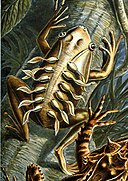Fichièr:Haeckel Batrachia.jpg

Talha d'aquesta previsualizacion: 424 × 599 pixèls. Autras resolucions : 170 × 240 pixèls | 339 × 480 pixèls | 543 × 768 pixèls | 724 × 1 024 pixèls | 2 323 × 3 284 pixèls.
Fichièr d'origina (2 323 × 3 284 pixèl, talha del fichièr: 2,17 Mo, tipe MIME: image/jpeg)
Istoric del fichièr
Clicar sus una data e una ora per veire lo fichièr tal coma èra a aqueste moment
| Data e ora | Miniatura | Dimensions | Utilizaire | Comentari | |
|---|---|---|---|---|---|
| actual | 24 febrièr de 2006 a 03.17 |  | 2 323×3 284 (2,17 Mo) | Ragesoss | improve version, based on same original scan |
| 11 febrièr de 2006 a 00.22 |  | 2 318×3 280 (2,21 Mo) | Ragesoss | The 68th plate from Ernst Haeckel's 1899 ''Kunstformen der Natur'', depicting frogs classified as Batrachia. Category:Ernst Haeckel |
Paginas que contenon lo fichièr
La pagina çaijós compòrta aqueste imatge :
Usatge global del fichièr
Los autres wikis seguents utilizan aqueste imatge :
- Utilizacion sus arz.wikipedia.org
- Utilizacion sus ast.wikipedia.org
- Utilizacion sus az.wikipedia.org
- Utilizacion sus ban.wikipedia.org
- Utilizacion sus be.wikipedia.org
- Utilizacion sus bg.wikipedia.org
- Utilizacion sus ca.wikipedia.org
- Utilizacion sus ca.wikibooks.org
- Utilizacion sus ceb.wikipedia.org
- Utilizacion sus ckb.wikipedia.org
- Utilizacion sus dag.wikipedia.org
- Utilizacion sus de.wikipedia.org
- Utilizacion sus din.wikipedia.org
- Utilizacion sus el.wikipedia.org
- Utilizacion sus en.wikipedia.org
- Wikipedia:Featured pictures thumbs/04
- Wikipedia:Picture of the day/June 2006
- User:Ragesoss/Haeckel
- Wikipedia:Featured picture candidates/Haeckel Batrachia.jpg
- Wikipedia:Wikipedia Signpost/2006-03-13/Features and admins
- Wikipedia:Featured picture candidates/March-2006
- Talk:Frog/Archive 3
- User talk:Ragesoss/Archive1
- Wikipedia:Picture of the day/June 12, 2006
- Wikipedia:POTD/June 12, 2006
- Wikipedia:POTD column/June 12, 2006
- Wikipedia:POTD row/June 12, 2006
- Kunstformen der Natur
- User:Samsara/Frog/Stable
- User:RichardF/POTD
- Wikipedia:WikiProject Germany/Gallery
- User talk:RichardF
- User:Froggyyes~enwiki
- Wikipedia:Featured pictures/Animals/Amphibians
- Unclean spirit
- User:Xophist/s5
- Wikipedia:Wikipedia Signpost/2006-03-13/SPV
- Talk:Alfred Russel Wallace/Archive 1
- Portal:Amphibians/Selected picture
- User:The Transhumanist/Sandbox144
Veire l'utilizacion globala d'aqueste fichièr.






